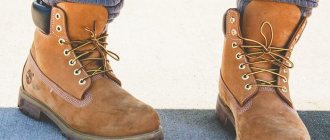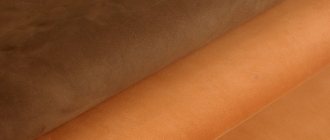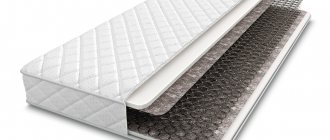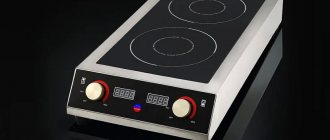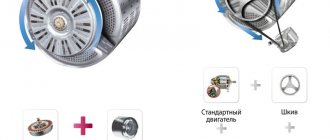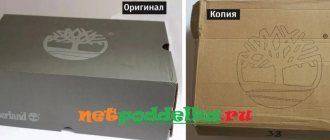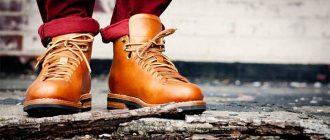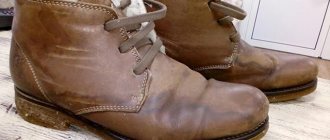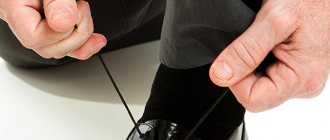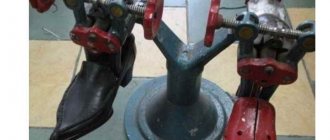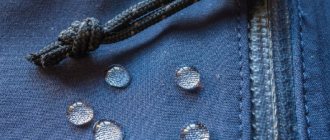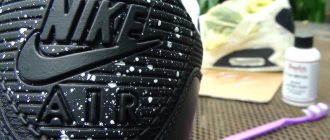What kind of material is nubuck for shoes? Read more in the article.
Nubuck – natural leather with fine pile. Shoes made from this material are very popular because they are not only strong and durable, but also have a presentable, expensive appearance.
Read an article on our website about how to paint shoes made of leather, suede or nubuck at home . It provides valuable tips and advice.
It is similar in many ways to suede, however, it also has its own characteristics that you need to know about if you want to purchase shoes made from this material. Read more in this article.
What kind of material is nubuck - description
As stated in the free encyclopedia Wikipedia:
“Nubuck is a fine-haired leather that is subjected to chrome tanning during the tanning process. The skin is sanded from the face with fine abrasives such as sand or fine-grained sandpaper. Nubuck is similar in appearance to suede, but is made from other types of leather, mainly from cattle.”
By the way, nubuk and nabuk are misspelled names of the material.
Description in the table:
| What is it called differently | nubuck |
| Natural material or synthetic? | genuine leather and synthetic substitute |
| What does it look like, what does it feel like? | dense, hard, smooth, finely fleecy |
| Application | shoes, clothing, upholstery, leather goods |
| Does it stretch or not? | weak |
| Cleaning Recommendations | dry cleaning with a special brush, eraser, foam |
| Wash | undesirable |
| Drying | at room temperature |
| Kinds | natural nubuck, artificial, nubuck-oil |
Difference with suede
The difference is in the origin and method of tanning the leather. The table clearly shows how nubuck differs from suede and what their performance properties are.
Table - Differences between suede and nubuck
| Options | Suede | Nubuck |
| Tanning | — Fats of vegetable and animal origin | — Mineral salts (chromic) followed by grinding of the top layer |
| Leather | — Small cattle | — Cattle |
| Extensibility | — High | — Average |
| Waterproof | — Average | — Low |
| Shock resistance | — Average | — High |
| Wear resistance | — Average | — High |
| Area of application (most common) | - Outerwear; - bags; - hats; - wallets; - shoes (rarely) | - Shoes; - bags; — belts; - jackets; - furniture |
Fun fact: Most “suede” shoes are actually made from nubuck. Due to its softness and high stretchability, suede is not used in clothes without a thick lining. It is used very rarely for sewing shoes - the material quickly deforms and reacts sensitively to deicing agents. But for jackets, wallets and bags - just right. But suede at a low price is most likely nubuck.
Properties
Fine pile on nubuck gives the impression of velvety. The material appears to have an uneven color. Many people find the so-called “plush effect” very attractive, despite the fact that nubuck shoes look stronger and more practical than suede ones. This is true. Due to the use of cattle leather, nubuck is thicker and stronger. But due to the specifics of processing, it is more susceptible to moisture.
Properties of natural nubuck:
| Waterproof | low |
| Breathability | high |
| Impact resistance | high |
| Tensile strength | high |
| Dirt resistance | low |
| Wear resistance | high |
Sanding gives the leather a lighter, more elegant shade, and treatment with chrome salts makes it soft, highly porous, and breathable. At the same time, it becomes vulnerable to moisture. Nubuck swells from water, and after drying it can become too hard and rough.
Pros and cons of the material
The advantages of nubuck shoes include the following:
- strength;
- comfortable wearing;
- long service life;
- optimal tactile qualities.
But there were some downsides, namely:
- the need to purchase a special brush for care;
- difficult cleaning;
- mandatory use of various antistatic agents for material processing.
Kinds
There are 3 types of nubuck:
- Natural. It is a specially treated animal skin. Sometimes leather with mild defects is used to make nubuck. After sanding they become invisible.
- Artificial. It is a type of flock and is made from polymer materials. Finely chopped pile is glued onto a dense textile base (woven or not). Uniform distribution of villi is achieved through a constant electrostatic field. Unlike traditional flock, it has a Teflon coating. Nubuck fabric is rare and is used mainly as upholstery for furniture.
- Nubuck-oil. This is a premium natural material, oiled to protect against moisture. It feels damp to the touch, is darker in color and a little heavier than regular nubuck. Thanks to the fatty film, nubuck oil practically does not get wet and does not become dirty. It is considered the highest quality and most expensive.
Differences from suede
Nubuck, leather and suede are used by designers to create different types of clothing - trousers, skirts, raincoats, jackets, hats and gloves, as well as for the production of shoes and accessories. But the materials differ in their characteristics.
Natural suede is made exclusively from deerskin. It is processed, tanned, after which it becomes soft. Only the skin of a young animal is used. It has short soft bristles and a delicate texture. Nubuck is made from buffalo, cow or ox leather. For small items - gloves, key rings, bookmarks - the skin of small calves is used.
Suede is tanned using oils and fats. This is how masters achieve softness and elasticity. Nubuck is treated with chrome plating using fine salt and sand. As a result of this procedure, the material becomes soft, but quickly begins to get wet and gets dirty easily. Nubuck has a fairly short pile, while suede has a longer pile.
Suede is more suitable for long-term use. It is more resistant to moisture and dirt. Natural nubuck quickly absorbs water and dust, is less easy to clean and loses its attractiveness in a shorter time.
Advantages and disadvantages
Nubuck is one of the most popular materials for the production of women's and men's shoes. Both genuine leather and substitute leather are in high demand. Their advantages and disadvantages are different.
Table:
| Natural nubuck for shoes | Artificial nubuck for shoes | ||
| pros | Minuses | pros | Minuses |
| Pliable, easily adapts to the shape of the foot, does not rub | Gets wet without using special impregnation | Attractive appearance at low cost | Does not allow air to pass through, due to which feet in such shoes often sweat and freeze |
| Breathable, feet do not sweat in shoes, even if it is hot | Difficult to maintain and requires the use of special cleaning products to maintain a neat appearance | Doesn't get wet | A special brush is required for care |
| Excellent heat retention | Lasting | Lasts 1-3 seasons | |
| With proper care it lasts a very long time | Relatively easy to care for | ||
| Resistant to creases | |||
How to restore the surface?
If the shoes have faded and the color is not as bright as before, they can be painted with paint for suede and nubuck, which is sold in shoe stores. Before painting, you should make sure that the shoes are free of dust, dirt, and grease, otherwise the color will not apply evenly.
It is necessary to spray the aerosol evenly, having previously protected all elements that should not be painted over, and wait until it dries completely.
Important! Do not use leather dyes; they are not suitable for this material. Shoes should be painted before spraying the impregnation.
Caring for nubuck
To ensure that nubuck shoes do not lose their presentable appearance, they must be looked after regularly.
It is recommended to immediately acquire special tools:
- a brush to lift lint and clean dry dirt and dust;
- eraser for erasing stains;
- aerosol with moisture- and dirt-repellent properties;
- cleaning foam;
- spray paint to restore color.
Regular care is as follows:
- Treat boots with a water-repellent aerosol immediately after purchase, and then about once every 1-2 weeks (with regular wear).
- Daily brushing (dry brushing only).
- Dry daily at room temperature and ventilate.
- Washing (replacing) insoles as they become dirty.
- Removing stubborn stains with an eraser.
- Cleaning heavy stains with cleaning foam or soapy water and a soft cloth.
- Dyeing nubuck every 2-3 seasons.
It is recommended to dry thoroughly wet shoes with an electric shoe dryer or use moisture-absorbing bags or newspapers. It is important that the boots dry within 24 hours. The use of alcohol and solvents for cleaning is strictly prohibited. Nubuck shoes should only be stored in a canvas bag or box with ventilation holes.
Artificial nubuck and nubuck oil
Nubuck made from synthetic materials and natural nubuck impregnated with oil are not so demanding to care for. They become less dirty and practically do not absorb water. But even here you cannot do without specialized tools.
For shoes to last for a long time, you need to:
- Use moisture- and dirt-repellent agents.
- Remove dirt and lift the pile with a special brush.
- Air your shoes regularly and wash (change) the insoles.
The difference is that such shoes can withstand wet cleaning more easily. You can wash it with ordinary soapy water. It also holds paint better and practically does not fade. You probably won't need a can of dye. But an anti-sweating foot spray may come in handy.
Traditional methods of cleaning
If the pollution is insignificant, for example, greasy places have appeared on the sofa or bag, and there are no specialized products at home, “folk wisdom” will come to the rescue. The table describes recipes for homemade solutions for effectively cleaning nubuck.
Table - Folk recipes for cleaning nubuck
| Recipe | What you will need | How to clean |
| To remove stains and grime | — Water — 1 l; - table vinegar - 15 ml | — Dampen a soft sponge in the solution; - apply the composition over the entire surface; - additionally walk through especially dirty places; - blot the excess with a soft cloth or paper towels (without pressing); - dry |
| — Water — 200 ml; - ammonia - 50 ml | ||
| To raise the pile | — Steam (you can use a steam generator, a boiling kettle) | — Clean the material from dust and dirt; — direct a stream of steam to the surface; - keep a distance of 20 cm |
These recipes will not solve global problems, but they can remove light stains. They are convenient to use for cleaning upholstered furniture coated with nubuck. Especially if there are children or allergy sufferers in the house, and contact with “chemicals” may be unsafe.
Knowing how to care for nubuck at home, you can safely look at the display cases with things made from this fashionable material. And maybe in the coming season we can show off in “indecently beautiful” boots.
Video on the topic
Price
In most cases, nubuck shoes cost about the same as leather ones (if you compare shoes of the same model). Suede is priced a little more expensive due to more complex production.
But there are also exceptions. For example, the price for hand-sewn shoes made of high-quality nubuck will be tens of times higher than for suede boots from a chain store. Or another example. Nubuck, made from leather with defects (which, remember, are easily erased during its production) can cost several times less than leather.
The story with the substitute is clear. It's always cheaper:
The average cost of low autumn boots made of natural nubuck is 8-10 thousand rubles. The same replacement model will cost 3-4 thousand rubles.
Types of material
To better understand how to keep products made from this material in order, you must first understand which type it belongs to:
- Natural.
- Artificial.
- Oiled or nubuck oil.
Natural
Made from the skin of large animals. Due to its strength and pleasant soft surface, it is used, in addition to shoes, for covering furniture. Here are a few features of nubuck:
- Breathability.
- Strength.
- Resistant to moisture.
- Resistant to deformation and scratches.
Quality depends greatly on the manufacturer. In Asian countries, the “doubling” method is widely used, when the skin is pulled onto a drum, saturated with steam and stretched 1.5-2 times. Then they are fixed, treated with special chemical compounds and dried. This reduces the cost of raw materials, but impairs its strength and wear resistance. In addition, the pores of the “stretched” material quickly become clogged with dust, making it very difficult to clean. You can take such shoes if you do not expect large loads on them.
If possible, you should give preference to good European brands that do not use such “technologies”.
Artificial
Artificial nubuck, or eco-nubuck, looks very similar to natural nubuck, but costs several times less. Synthetic material has the following properties:
- High wear resistance.
- Environmentally friendly.
- Low maintenance requirements.
- The moisture resistance of artificial nubuck is much higher than that of “real” boots.
- Poor air permeability, which affects the comfort and health of the feet.
Oil
Nubuck-oil, or oiled (greased) nubuck, is treated with special fats after tanning. As a result of this treatment, the soft velvety texture is lost, but moisture-repellent properties appear. Hydrophobic nubuck is heavier than usual and looks more wet.
Material properties:
- Complete protection from moisture.
- It requires virtually no maintenance, can withstand high loads, and has a long service life.
- The cost is quite high, although it corresponds to the quality.
Reviews
There are extremely conflicting reviews about nubuck for shoes. As often as he is praised, he is just as often criticized. Mostly nubuck shoes appeal to men. Here's what they write about him:
- Olga: “A lot depends on the quality of nubuck. My salamander boots lasted 3 years. And then I threw them away because I was tired of them. I have never thoroughly cleaned it. I just brushed away the dried dirt and wiped away the dusty marks with a cloth.”
- Igor: “I wear only nubuck shoes. I take regular ones, not oil. The main thing here is to buy water-repellent impregnation. It costs like an airplane, but the effect is obvious. Boots do not get wet, salt solutions do not stick, shoes are always clean. Beauty! I thoroughly soak a new pair (pour out 100-150 ml). Then I just refresh it.”
- Lizochka: “I bought nubuck winter boots. This is something! Just stand in them nicely for an hour, that’s all. My feet feel stuffy and sweaty. It’s like walking in rubber boots.”
- Eva: “I’m a shoe fanatic. Which one I don't have. I took boots made of nubuck (artificial) for running in the slush. And cheap, and they don’t become limp. There is no discomfort in wearing. My feet don’t sweat, they’re as comfortable as wearing slippers.”
- Natalya: “I bought red nubuck boots. Oh, and I suffered. Better than with suede shoes. You could at least wash them with a damp cloth. But nubuck gets a little wet, and after drying, disgusting stains and stains remain. You just need to clean it with a special product. But still, after cleaning, the paint washes off. The color of the boots on the toes is very different from the top. It is impossible to match the paint to match. I will never buy nubuck shoes again.”
General care recommendations
Natural material will have to be taken care of more carefully. It should not be rubbed too hard because whitish marks, scratches, lint or shiny areas will appear on the surface. Wet shoes should be dried by stuffing them with crumpled paper to avoid deformation. A dry surface should be cleaned with a soft rubber brush without applying significant force.
The artificial one can simply be wiped with a damp cloth, and then slightly straightened with a soft brush - that’s all the care is.
When it comes to care products, it is best to use special sprays. They cover the surface with a thin layer, mask minor damage and do not “glue” the pile, preserving the properties of the material and its beauty.
Questions and answers
How to distinguish natural nubuck from artificial?
Natural material costs many times more. In addition, it is heavier, softer and more pleasant to the touch. If the nubuck is not impregnated with oil (nubuck-oil), then when a drop of water hits the surface, a dark spot will form. On artificial material, water will not leave any traces, will not be absorbed, but will rather roll off or dry out. But the surest way to distinguish a craft is to pay attention to the markings. Products made from genuine leather always have a mark in the form of a stretched animal skin. Synthetic nubuck is marked with a diamond.
Which shoes are better, natural nubuck or artificial?
Shoes made of genuine leather are always more valuable. It is warmer, more comfortable, and more durable with proper care. Synthetic nubuck shoes will not be as comfortable, but they will be easier to care for. In addition, she is not afraid of rain, does not change color from water, and does not shed.
Nubuck is a high-quality material for shoes. Natural boots are comfortable to wear, warm, elastic and durable. They will not tear for 3-5 years or longer. But they can quickly lose their attractiveness. Nubuck does not tolerate rough handling. It should not be rubbed, scratched, left wet or dirty. If you're not prepared to maintain it regularly, it's best to save your shoes for dry weather or choose a pair made from traditional smooth leather.
Does artificial or natural nubuck get wet?
Natural nubuck can get wet
Nubuck is a durable material, especially if it is natural. But, alas, it is not without its shortcomings. Shoes made from this leather tend to allow water to pass through. And although this takes a lot of time, wearing nubuck boots for a long time in conditions of high humidity outside leads to the product getting wet.
Worth knowing: If you do not completely dry a wet natural nubuck product, creases will begin to appear on its surface. Therefore, always use newsprint or a special device to dry your boots from the inside.
As for artificial nubuck, it is more durable and hardy. Because its surface is harder than natural material, it repels water much more effectively. Therefore, there is less fear of such a product getting wet.
If your shoes do get wet, then read the article on our website about how to quickly dry boots made of leather, suede or nubuck .
However, in both cases, other nuances are possible:
- It is important to monitor the integrity of the soles of your boots, as they can peel off over time.
- Water “enters” faster into the resulting cracks.
- Therefore, your feet may also be wet after wearing shoes.
To avoid this, experts recommend taking special preventative measures. It is carried out in specialized shoe repair shops. In addition, preventive measures add durability to shoes and reduce their wear, so it is advisable not to spare money on their implementation. It costs much less than buying new leather boots. Good luck!
Prices
Nubuck belongs to the premium class of upholstery and shoe materials. Its price is slightly lower than for suede, but higher than for our usual leather without surface treatment.
Natural material can be purchased in specialized stores at a price of 0.7 dollars per 1 square inch. Naturally, the price rises when animals such as yak and elk are taken for its production, and also subjected to fine processing of the front surface.
Synthetic or artificial nubuck for carpets, upholstery and other needs can cost $3-5 per square meter. Depending on the number of layers of polymers, their thickness and structure. Usually it goes in the “Fabrics” and “Artificial Leather” sections.
Nubuck is aesthetics and beauty. It is used to upholster Italian furniture , thanks to it the surfaces of armchairs and sofas become pleasant to the touch. Of course, there is a huge difference between natural and synthetic material.
Natural is more suitable for the bedroom. It cannot be cleaned and washed very often; it absorbs moisture and is afraid of strong mechanical influences. But its appearance evokes only pleasant thoughts; you immediately want to touch it, lie down on its surface. The tactile sensations when touching it are almost the same as when touching suede.
Artificial is more practical and common. It can be found in car showrooms, on the floors of children's rooms, in living rooms and kitchens. Its water-repellent properties allow this material to be washed and cleaned a considerable number of times.
Application area
As has been mentioned more than once above, the main use of artificial nubuck is the production of shoes. Today there are many models made from this textile material. Moreover, modern manufacturers offer different types of shoes: boots, sneakers, ankle boots, boots, even elegant shoes. The products are distinguished by their stylish design, variety of colors, and beauty.
However, the material described is not only used for shoes. It is used to make original bags and bright accessories. Craftswomen use artificial nubuck in their own crafts. It is used to create home textiles, cute toys, authentic panels, etc.
The material is often used for upholstery of furniture: sofas, armchairs, chairs, etc. In the interior it looks elegant, ideal for today's popular styles: minimalism, eco, modern.
